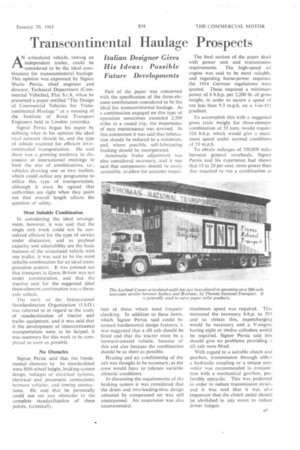Transcontinental Haulage Prospects
Page 39

If you've noticed an error in this article please click here to report it so we can fix it.
Italian Designer Gives His Ideas: Possible Future Developments
AN articulated vehicle, towing an independent trailer, could be considered to be the ideal combination for transcontinental haulage. This opinion was expressed by Signor Mario Persia, chief • engineer and director, Technical Department (Commercial Vehicles), Fiat S.t.A. when he presented a paper entitled "The Design of Commercial Vehicles for Transcontinental Haulage " at a meeting of the Institute of Road Transport Engineers held in London yesterday.
Signor Persia began his paper by definingwhat in his opinion the ideal road network should be, and the type of vehicle required for efficient intercontinental transportation. He said there was a growing tendency in discussion at international meetings to limit the size of combinations, i.e., vehicles drawing one or two trailers, which could defeat any programme to utilize this type of transportation, although it must be agreed that authorities are right when they point out that overall length affects the question of safety.
Most Suitable Combination
in considering the ideal arrangement, however, it was said that the single unit truck could not be considered efficient for the type of -service under discussion, and as payload capacity and adaptability are the basic features of the articulated vehicle with one trailer, it was said to be the most suitable combination for an ideal transportation pattern. It was pointed out that transport in Great Britain was not under consideration, and that the tractive unit for the suggested ideal three-element combination was a threeaxle vehicle.
'Fhe work of the international Standardization Organization(1.S.O.) was referred to in regard to the study of standardization of tractor and trailer equipment, and it was said that if the development of intercontinental transportation were to be helped, it was necessary for this work to be completed as soon as possible.
No Obstacles Signor, Persia said that the fundamental elements to be standardized were fifth-wheel height, braking-system design, voltages of electrical systems, electrical and pneumatic connections between vehicles, and towing connections. He said that he personally could not see any obstacles to the complete standardization of these points, technically.
Part of the paper was concerned with the specification of the three-element combination considered to be the ideal for transcontinental haulage. As a combination engaged on this type oC operation sometimes exceeded 2,500 miles in a round trip, the importance of easy maintenance was stressed. In this connection it was said that lubrication should be reduced to a minimum, and, where possible, self-lubricating bushing should, be incorporated.
Automatic brake adjustment was also considered necessary, and it was said that components should he easily accessible, to allow for accurate in spec
tion of those winch need frequent checking. In addition to these items, which Signor Persia said could be termed fundamental design features, it was suggested that a tilt cab should be fitted and that the tractor must be a forward-control vehicle, because of this and also because the combination should be as short as possible.
Heating and air conditioning of the cab was thought to be necessary, as the crew would have to tolerate variable climatic conditions.
In discussing the requirements of the braking system it was considered that the drum and two-leading-shoe design actuated by compressed air was still unsurpassed. Air suspension was also recommended. Thefinal section of the paper dealt with power unit and transmission requirements. The high-speed oil engine was said to be most suitable, and regarding horse-power required. the 1954 German regulations were quoted. These required a minimum power of 6 b.h.p. per 2,200 lb. of gross weight, in order to secure a speed of not less than 9.3 m.p.h. on a 1-in-l6} gradient.
To accomplish this with a suggested gross train weight for three-element combination of 53 tons, would require 324 b.h.p. which would give a maximum speed under normal conditions of 53 m.p.h.
To obtain mileages of 350,000 miles between general overhauls, Signor Persia said his experience had shown that 15 to 20 per cent, more power than that required to run a combination at
maximum speed was required. This increased the necessary b.h.p. to •390 and to obtain this, supercharging would be necessary and a V-engine having eight or twelve cylinders would be required. Signor Persia said this should give no problems providing a tilt cab were fitted.
With regard to a suitable clutch and gearbox, transmission through either a hydraulic coupling or a torque converter was recommended in conjunction with a mechanical gearbox, preferably epicyclic. This was preferred in order to reduce transmission strain, and it was said that it was also important that the clutch pedal should be abolished in any event to reduce driver fatigue.




















































































































